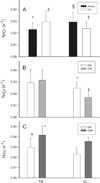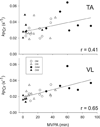Age-related changes in oxidative capacity differ between locomotory muscles and are associated with physical activity behavior
- PMID: 22236246
- PMCID: PMC3725816
- DOI: 10.1139/h11-135
Age-related changes in oxidative capacity differ between locomotory muscles and are associated with physical activity behavior
Abstract
There is discrepancy in the literature regarding the degree to which old age affects muscle bioenergetics. These discrepancies are likely influenced by several factors, including variations in physical activity (PA) and differences in the muscle group investigated. To test the hypothesis that age may affect muscles differently, we quantified oxidative capacity of tibialis anterior (TA) and vastus lateralis (VL) muscles in healthy, relatively sedentary younger (8 YW, 8 YM; 21-35 years) and older (8 OW, 8 OM; 65-80 years) adults. To investigate the effect of physical activity on muscle oxidative capacity in older adults, we compared older sedentary women to older women with mild-to-moderate mobility impairment and lower physical activity (OIW, n = 7), and older sedentary men with older active male runners (OAM, n = 6). Oxidative capacity was measured in vivo as the rate constant, k(PCr), of postcontraction phosphocreatine recovery, obtained by (31)P magnetic resonance spectroscopy following maximal isometric contractions. While k(PCr) was higher in TA of older than activity-matched younger adults (28%; p = 0.03), older adults had lower k(PCr) in VL (23%; p = 0.04). In OIW compared with OW, k(PCr) was lower in VL (∼45%; p = 0.01), but not different in TA. In contrast, OAM had higher k(PCr) than OM (p = 0.03) in both TA (41%) and VL (54%). In older adults, moderate-to-vigorous PA was positively associated with k(PCr) in VL (r = 0.65, p < 0.001) and TA (r = 0.41, p = 0.03). Collectively, these results indicate that age-related changes in oxidative capacity vary markedly between locomotory muscles, and that altered PA behavior may play a role in these changes.
Figures



Similar articles
-
In vivo oxidative capacity varies with muscle and training status in young adults.J Appl Physiol (1985). 2009 Sep;107(3):873-9. doi: 10.1152/japplphysiol.00260.2009. Epub 2009 Jun 25. J Appl Physiol (1985). 2009. PMID: 19556459 Free PMC article.
-
Effect of age on in vivo oxidative capacity in two locomotory muscles of the leg.Age (Dordr). 2014;36(5):9713. doi: 10.1007/s11357-014-9713-5. Epub 2014 Sep 17. Age (Dordr). 2014. PMID: 25227177 Free PMC article.
-
Effects of old age and contraction mode on knee extensor muscle ATP flux and metabolic economy in vivo.J Physiol. 2021 Jun;599(12):3063-3080. doi: 10.1113/JP281117. Epub 2021 May 12. J Physiol. 2021. PMID: 33876434
-
Age-related changes in ATP-producing pathways in human skeletal muscle in vivo.J Appl Physiol (1985). 2005 Nov;99(5):1736-44. doi: 10.1152/japplphysiol.00566.2005. Epub 2005 Jul 7. J Appl Physiol (1985). 2005. PMID: 16002769
-
Oxidative capacity varies along the length of healthy human tibialis anterior.J Physiol. 2018 Apr 15;596(8):1467-1483. doi: 10.1113/JP275009. Epub 2018 Mar 25. J Physiol. 2018. PMID: 29455454 Free PMC article.
Cited by
-
Near-infrared assessments of skeletal muscle oxidative capacity in persons with spinal cord injury.Eur J Appl Physiol. 2013 Sep;113(9):2275-83. doi: 10.1007/s00421-013-2657-0. Epub 2013 May 24. Eur J Appl Physiol. 2013. PMID: 23703066 Free PMC article.
-
Impact of aging on mitochondrial respiration in various organs.Physiol Res. 2022 Dec 31;71(S2):S227-S236. doi: 10.33549/physiolres.934995. Physiol Res. 2022. PMID: 36647911 Free PMC article.
-
The clinical impact and biological mechanisms of skeletal muscle aging.Bone. 2019 Oct;127:26-36. doi: 10.1016/j.bone.2019.05.021. Epub 2019 May 22. Bone. 2019. PMID: 31128290 Free PMC article. Review.
-
Age-related structural alterations in human skeletal muscle fibers and mitochondria are sex specific: relationship to single-fiber function.J Appl Physiol (1985). 2014 Jun 15;116(12):1582-92. doi: 10.1152/japplphysiol.01362.2013. Epub 2014 May 1. J Appl Physiol (1985). 2014. PMID: 24790014 Free PMC article.
-
Sarcopenic Obesity: Involvement of Oxidative Stress and Beneficial Role of Antioxidant Flavonoids.Antioxidants (Basel). 2023 May 8;12(5):1063. doi: 10.3390/antiox12051063. Antioxidants (Basel). 2023. PMID: 37237929 Free PMC article. Review.
References
-
- Arnold DL, Matthews PM, Radda GK. Metabolic recovery after exercise and the assessment of mitochondrial function in vivo in human skeletal muscle by means of 31P NMR. Magn. Reson. Med. 1984;1(3):307–315. PMID:6571561. - PubMed
-
- Barrientos A, Casademont J, Rotig A, Miro O, Urbano-Marquez A, Rustin P, Cardellach F. Absence of relationship between the level of electron transport chain activities and aging in human skeletal muscle. Biochem. Biophys. Res. Commun. 1996;229(2):536–539. PMID:8954933. - PubMed
-
- Bass A, Gutmann E, Hanzlikova V. Biochemical and histochemical changes in energy supply enzyme pattern of muscles of the rat during old age. Gerontologia. 1975;21(1):31–45. PMID:166901. - PubMed
-
- Brierley EJ, Johnson MA, James OFW, Turnbull DM. Effects of physical activity and age on mitochondrial function. QJM. 1996;89(4):251–258. PMID:8733511. - PubMed
-
- Brierley EJ, Johnson MA, Bowman A, Ford GA, Subhan F, Reed JW, et al. Mitochondrial function in muscle from elderly athletes. Ann. Neurol. 1997;41(1):114–116. PMID:9005875. - PubMed
Publication types
MeSH terms
Substances
Grants and funding
LinkOut - more resources
Full Text Sources
Medical

